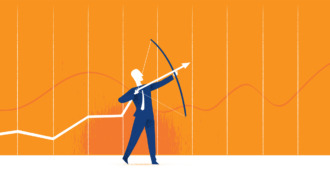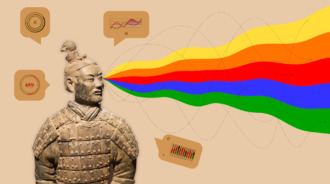

While it’s generally accepted that losses pull irrational traders out of asset markets, a study from INSEAD showed that overconfident traders don’t leave the market despite losses. However, those who want to avoid failures, may consider a Bollinger Bands trading strategy.
Bollinger Bands is a popular trading indicator used by traders and investors to define periods when the market is quiet or highly volatile. It’s one of the easiest and most effective trading tools. Keep reading to learn how to apply the indicator to your trades.
Bollinger Bands: the basics
Bollinger Bands is a technical tool that was developed by John Bollinger. The indicator consists of three lines: a middle line presented by a simple moving average and upper and lower bands, which are standard deviations above and below the middle line.
The Bollinger Bands indicator is applied to define a price’s volatility. When the bands are close to each other, the market is calm. If the price fluctuations increase, the distance between the bands widens. It can also help traders determine whether the market is overbought or oversold.
When applying the indicator on the price chart, you need to determine only one parameter — period. The standard setting is 20. It’s usually used for higher timeframes, starting from 1-day. However, it doesn’t mean you shouldn’t use Bollinger Bands for short-term trades. You just need to reduce the period. Lower periods are more sensitive to price changes. It leads to a larger number of signals.
Bollinger Bands: definition and meaning for traders
Bollinger Bands are technical analysis forms that traders use for plotting trend lines. These lines are often at a two-standard deviation distance from the security price of an SMA (simple moving average). Since traders generally look for incremental price movements, determining the volatility can help them calculate the potential net profit.
The goal of Bollinger Bands is to inform traders when they should exit or enter a position. It does that by finding out when an asset is being overbought or oversold. Once the signal is received, traders may buy or sell an asset to obtain a profit.
Created by John Bollinger, Bollinger Bands signal potential changes in volatility. When you have security ranges (e.g., currency pairs), the Bollinger Bands can offer you clear signals as to when you should buy or sell an asset.
Bear in mind that sometimes this may lead to frustrating losses, as stop-out may occur ahead of time. This is why traders should consider using different factors as well when using Bollinger Bands. Use indicators to determine the exit and entry points, taking action accordingly.
How to calculate Bollinger Bands
Bollinger Bands are made out of three bands: lower, upper, and moving average. The easiest way to calculate the Bollinger Band is through a 20-day SMA (simple moving average) index applied to the middle band.
You calculate the upper band by taking the middle band, after which you add twice that amount’s daily standard deviation. To calculate the lower band, you take the middle band and subtract twice the daily standard deviation.
Once you have that in mind, use the following formulas to obtain your numbers:
TP = (High + Low + Close) / 3
BOLU = MA(TP,n)+m∗σ[TP,n]
BOLD = MA(TP,n)−m∗σ[TP,n]
Where:
· TP = Typical Price
· BOLD: Lower Bollinger Band
· BOLU = Upper Bollinger Band
· MA = Moving Average
· m = no. of standard deviations
· n = no. of smoothing period days
· σ[TP,n] = standard deviation over the past n TP periods

The buying channel
Bollinger Bands are set over a price chart that includes a moving average along with the lower and upper bands. Between each band and moving average line, you will see an area that creates a range, commonly referred to as a channel. Bollinger Bands will show changes in relative volatility through the width of the band. If the band is wide, so is the volatility.
The buying channel is the one set above the moving average. The spot rates within this region will stay high when compared to the moving average. They suggest an upward momentum, meaning that it is the perfect time to buy. It is the opposite of the selling channel below the moving average, which suggests a downward momentum.
Bollinger Bands trading strategies
Although you can develop your own trading strategy based on the Bollinger Bands indicator, there are three major ways to use it.
1. Bounce
The indicator’s bands are used as support and resistance levels. Thus, the upper band is a resistance boundary, while the lower band is a support boundary. You should remember that the price always tries to return to the middle line.
Thus, the idea is simple. When the price reaches the upper boundary, a trader can expect it to move down to the middle line. If the falling price reaches the lower boundary, a rebound towards the middle line can be expected. Such pullbacks can be used to enter the market.
The upper and lower bands are stronger on longer-term timeframes.
This approach works best when there is no strong trend, and the price moves sideways. It’s dangerous to apply this scheme when the price moves within a strong trend. During periods of solid trend, the bands widen. This may lead to wrong signals and losing trades.
2. Squeeze
As it was mentioned above, upper and lower boundaries serve as resistance and support levels. This means that the price is supposed to rebound from them. But it’s not always the case. In periods of a strong trend, the price may go beyond a band for a while.
This may work as an entry point for trend traders. If the price breaks above the upper boundary, you can open a long position. If the price goes below the lower band, you can open a short trade.
Usually, the distance between the bands narrows before the strong trend. Thus, this may work as a signal for early market entry. If you see the bands narrow, you can expect a strong trend to form.
3. Relative strength
The Bollinger Bands indicator also helps traders determine an asset’s strength relative to its recent price range. The price can be considered relatively low or undervalued if it fluctuates near the lower band and relatively high or overvalued if it’s near the upper band.
Confirm bands signal
You should remember that there is no trading strategy that would be built on one indicator or pattern solely. Traders always look for signal confirmations from other tools. The best way is to find confirmation from 1-2 technical instruments. A large number of tools will confuse you by providing mixed alerts.
- Chart patterns. As bouncing is one of the leading Bollinger Bands trading approaches, you should look for a confirmation of the market reversal. There are popular reversal patterns that can be combined with the Bollinger Bands tool. If the price is traded near the upper boundary, you should look for bearish patterns, including head and shoulders and double and triple top. If the price is near the lower band, you need bullish reversal patterns. They include inverse head and shoulders, double bottom, and triple bottom.
- Candlestick patterns. It’s also possible to get a confirmation on the price reversal from candlestick patterns. They usually consist of one or two candles. The top bearish reversal candlestick patterns are shooting star, evening star, and bearish harami. The leading bullish reversal patterns are a hammer, bullish harami, and bullish engulfing.
- Indicators. As Bollinger Bands can reflect oversold and overbought conditions, you can apply other indicators that provide similar signals. These are the Relative Strength Index (RSI) and Stochastic Oscillator. As for the price reversal alerts, you can also use RSI and Stochastic Oscillator or try such tools as MACD and Moving Averages.
Final thoughts
Bollinger Bands is a technical indicator that helps traders in key trading goals — determining market volatility and setting support and resistance levels. Moreover, it’s quite simple. There is only one parameter you should set before implementing the indicator on the price chart, and its signals are obvious. It’s also possible to build your own Bollinger Bands trading strategy based on this indicator by changing the period and applying it to different timeframes. Always remember that there is no perfect indicator, and every signal should be confirmed.
Disclaimer: No strategy can guarantee a 100% correct outcome of the trade.










